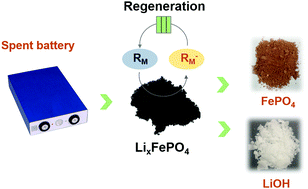A redox targeting-based material recycling strategy for spent lithium ion batteries†
Abstract
With the retirement of a massive amount of end-of-life lithium ion batteries (LIBs), proper disposal of the hazardous wastes and cost-effective valorization of useful materials have become increasingly pressing and have attracted extensive attention worldwide. The state-of-the-art recycling technologies, which are generally based on chemical leaching methods, have critical issues like enormous consumption of chemicals and secondary pollution, and generally involve tedious procedures. Here, we report an innovative approach in light of a redox targeting-based process and demonstrate the operation for the recycling of spent LiFePO4. With 0.20 M [Fe(CN)6]3− solution as a selective and regenerative redox mediator, LiFePO4 is readily broken down into FePO4 and Li+via the redox-targeting reaction between the redox mediator and the material, with a recycling efficiency for lithium removal up to 99.8% at room temperature. The reacted redox species are instantaneously regenerated on the electrode for subsequent rounds of reaction while Li+ is separated from the counter electrode compartment. Consequently, the consumption of chemicals is drastically minimized and secondary pollutants are eliminated. By virtue of the new process, high purity LiOH (99.90%) and FePO4 (99.97%) have been obtained. We envisage that this cost-effective and environment-friendly approach can be extended to other materials and promote the sustainability of LIB technologies.

- This article is part of the themed collection: Battery science and technology – powered by chemistry


 Please wait while we load your content...
Please wait while we load your content...